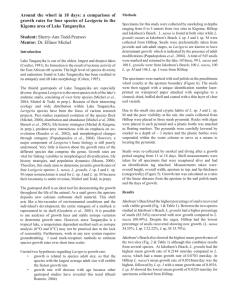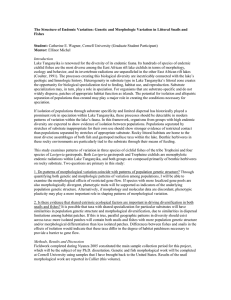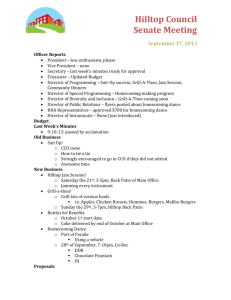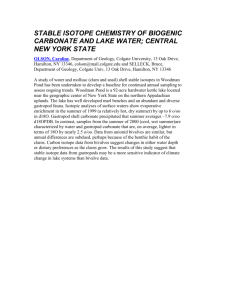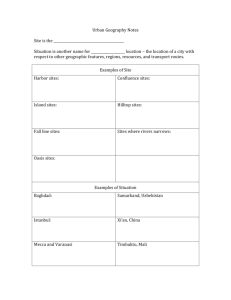Snail diversity and abundance at sediment disturbed and undisturbed sites... Kigoma, Tanzania
advertisement
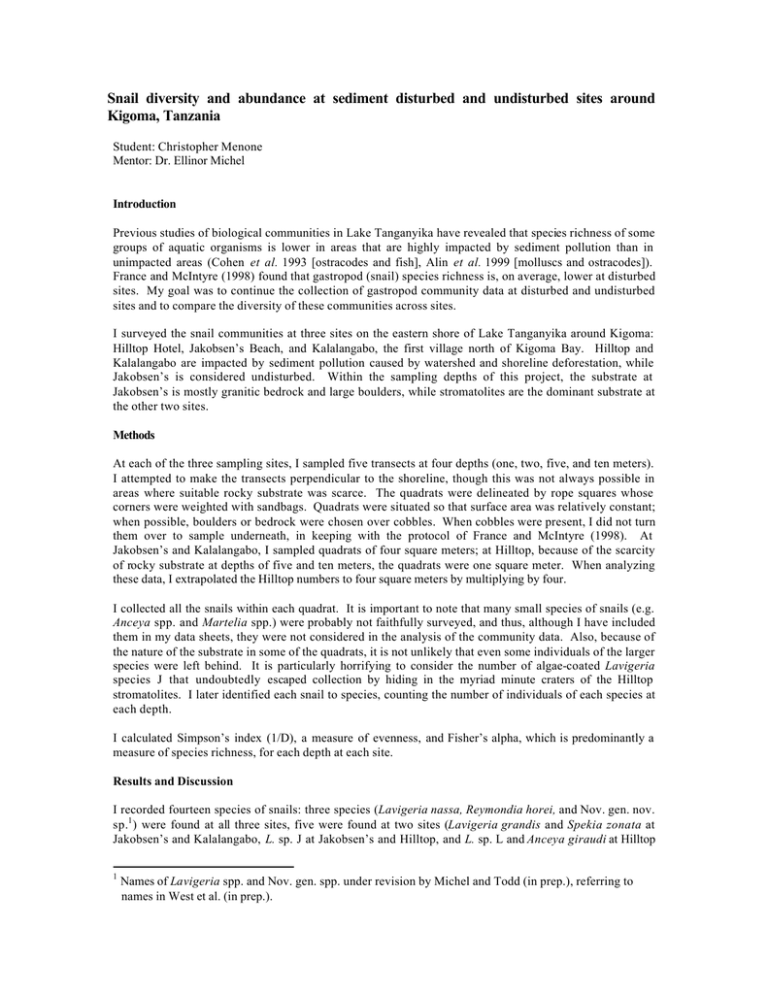
Snail diversity and abundance at sediment disturbed and undisturbed sites around Kigoma, Tanzania Student: Christopher Menone Mentor: Dr. Ellinor Michel Introduction Previous studies of biological communities in Lake Tanganyika have revealed that species richness of some groups of aquatic organisms is lower in areas that are highly impacted by sediment pollution than in unimpacted areas (Cohen et al. 1993 [ostracodes and fish], Alin et al. 1999 [molluscs and ostracodes]). France and McIntyre (1998) found that gastropod (snail) species richness is, on average, lower at disturbed sites. My goal was to continue the collection of gastropod community data at disturbed and undisturbed sites and to compare the diversity of these communities across sites. I surveyed the snail communities at three sites on the eastern shore of Lake Tanganyika around Kigoma: Hilltop Hotel, Jakobsen’s Beach, and Kalalangabo, the first village north of Kigoma Bay. Hilltop and Kalalangabo are impacted by sediment pollution caused by watershed and shoreline deforestation, while Jakobsen’s is considered undisturbed. Within the sampling depths of this project, the substrate at Jakobsen’s is mostly granitic bedrock and large boulders, while stromatolites are the dominant substrate at the other two sites. Methods At each of the three sampling sites, I sampled five transects at four depths (one, two, five, and ten meters). I attempted to make the transects perpendicular to the shoreline, though this was not always possible in areas where suitable rocky substrate was scarce. The quadrats were delineated by rope squares whose corners were weighted with sandbags. Quadrats were situated so that surface area was relatively constant; when possible, boulders or bedrock were chosen over cobbles. When cobbles were present, I did not turn them over to sample underneath, in keeping with the protocol of France and McIntyre (1998). At Jakobsen’s and Kalalangabo, I sampled quadrats of four square meters; at Hilltop, because of the scarcity of rocky substrate at depths of five and ten meters, the quadrats were one square meter. When analyzing these data, I extrapolated the Hilltop numbers to four square meters by multiplying by four. I collected all the snails within each quadrat. It is important to note that many small species of snails (e.g. Anceya spp. and Martelia spp.) were probably not faithfully surveyed, and thus, although I have included them in my data sheets, they were not considered in the analysis of the community data. Also, because of the nature of the substrate in some of the quadrats, it is not unlikely that even some individuals of the larger species were left behind. It is particularly horrifying to consider the number of algae-coated Lavigeria species J that undoubtedly escaped collection by hiding in the myriad minute craters of the Hilltop stromatolites. I later identified each snail to species, counting the number of individuals of each species at each depth. I calculated Simpson’s index (1/D), a measure of evenness, and Fisher’s alpha, which is predominantly a measure of species richness, for each depth at each site. Results and Discussion I recorded fourteen species of snails: three species (Lavigeria nassa, Reymondia horei, and Nov. gen. nov. sp.1 ) were found at all three sites, five were found at two sites (Lavigeria grandis and Spekia zonata at Jakobsen’s and Kalalangabo, L. sp. J at Jakobsen’s and Hilltop, and L. sp. L and Anceya giraudi at Hilltop 1 Names of Lavigeria spp. and Nov. gen. spp. under revision by Michel and Todd (in prep.), referring to names in West et al. (in prep.). Firgure 1: Snail Densities 1600 Individuals/4 sq.m. 1400 1200 1000 1m 2m 800 5m 10m 600 400 200 0 Jakobsen's Hilltop Kalalangabo Figure 2: Species evenness and richness 8 Simpson's index (1/D) [bars] # Species [lines] 7 6 1m 2m 5m 10m 5 4 3 2 1 0 Jakobsen's Hilltop Kalalangabo Figure 3: Species richness 1.4 Fisher's alpha 1.2 1 1m 2m 0.8 5m 0.6 10m 0.4 0.2 0 Jakobsen's Hilltop Kalalangabo and Kalalangabo), and six were found at only one site (Lavigeria coronata and Paramelania minor at Jakobsen’s; Martelia tanganyicensis, Lavigeria sp. X, and Bridouxia ponsonbyi at Hilltop; and L.sp. W at Kalalangabo). Snail density is greatest at Hilltop, with the greatest density occurring at a depth of two meters (Figure 1). At both disturbed sites, density drops sharply at ten meters. At Jakobsen’s, the undisturbed site, density is relatively constant across all depths. The decline of snail density at deeper areas of disturbed sites may be a result of uneven sediment distribution across depth caused by wave action near the lake surface. Species richness as measured by total number of species is greatest at the two shallow depths at Kalalangabo, where species richness decreases with depth (Figure 2). At both Jakobsen’s and Hilltop, species richness, as measured by both total species number and Fisher’s alpha, is lower at the shallower depths (Figures 2 and 3). In general, evenness decreases with depth at Jakobsen’s and Kalalangabo, while at Hilltop it is relatively constantly and low at all depths (Figure 2). This is due to the very strong numerical dominance of L. sp. J at this site. The various ecological factors that must be taken into account in a cogent interpretation of any study of gastropod diversity and community structure in this lake are indeed rather daunting. Care should be taken not to allow instances of point endemism (e.g. L. coronata, which is restricted to a small stretch of coastline to the south of Jakobsen’s Beach) to confound interpretations of the effects of local environmental conditions. The possible metapopulation structures of the members of gastropod communities, with the resulting high degree of spatial and temporal variability among snail populations, can only be resolved through long-term monitoring over large areas. The founding and extinction of local populations can be truly understood in the context of sediment pollution only when we have an idea of natural turnover rates. A study of microhabitat preference among members of the gastropod communities of Lake Tanganyika, such as the one envisioned but not realized for Nyanza 2000, would doubtless provide valuable baseline data for further studies of gastropod diversity and community structure. Phenotypic variation within species between sites should also be looked into. Acknowledgements I would like to thank Dr. Ellinor Michel for being a fabulous mentor. She is both incredibly knowledgeable about the snails and wonderfully amusing to work with. I would also like to thank Mr. Pete McIntyre, Miss Katja Hora, Miss Megan Phifer, Dr. Andy Cohen, and Mr. Robert Wakafumbe for playing the role of dive buddies and collaborators. I would be remiss to neglect acknowledging Issa for his boating ability and general coolness. I’d also like to make a shout out to Heather, who is very nice. Robia too. Of course, where would I be without the snails themselves? I’d like to thank the gastropod community of Lake Tanganyika, especially those individuals who will never again mow the sweet algae of their mother lake. References Alin, S. R., et al. 1999. Effects of landscape disturbance on animal communities in Lake Tanganyika, East Africa. Conservation Biology 13: 1017-1033. Cohen, A. S., et al. 1993. The impact of sediment pollution on biodiversity in Lake Tanganyika. Conservation Biology 7: 667-677. France , K., and P. McIntyre. 1998. Gastropod community ecology on the rocky eastern shore of Lake Tanganyika. The Nyanza Project 1998 Annual Report: 62-70.

